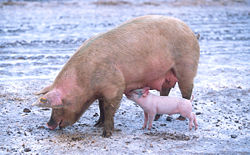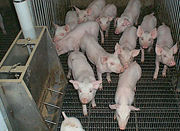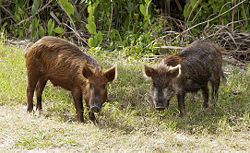Pig
| Pig | ||||||||||||||||||
|---|---|---|---|---|---|---|---|---|---|---|---|---|---|---|---|---|---|---|
 A domestic sow and her piglet.
|
||||||||||||||||||
| Scientific classification | ||||||||||||||||||
|
||||||||||||||||||
| Species | ||||||||||||||||||
|
Sus barbatus |
Pigs, also called hogs or swine, are a genus of even-toed ungulates within the family Suidae. The name pig, hog, or swine most commonly refers to the Domestic pig (Sus domestica) in everyday parlance, but technically encompasses several distinct species, including the Wild Boar. With around 2 billion on the planet, domestic pigs are also by far the most numerous pig species.[1][2] Pigs are omnivores, and despite their reputation for gluttony, they are generally social and intelligent animals.
Contents |
Description and behavior
A pig has a snout for a nose, small eyes, and a small tail, which may be curly, kinked, or straight. It has a thick body, short legs, and coarse hair. There are four toes on each foot, with the two large middle toes used for walking.
Pigs are omnivores, which means that they consume both plants and animals. Pigs will scavenge and have been known to eat any kind of food, including dead insects, worms, tree bark, rotting carcasses, garbage, and even other pigs. In the wild, they are foraging animals, primarily eating leaves, grasses, roots, fruits and flowers. Occasionally while in captivity, pigs may eat their own young if they become severely stressed. A typical pig has a large head with a long snout which is strengthened by a special bone called the prenasal bone and by a disk of cartilage in the tip. The snout is used to dig into the soil to find food and is a very sensitive sense organ.
Pigs have a full set of 44 teeth. The canine teeth, called tusks, grow continually and are sharpened by the lowers and uppers rubbing against each other.
Pigs that are allowed to forage may be watched by swineherds. Because of their foraging abilities and excellent sense of smell, they are used to find truffles in many European countries. Domesticated pigs are commonly raised as livestock by farmers for meat (called pork), as well as for leather. Their bristly hairs are also used for brushes. Some breeds of pigs, such as the Asian pot-bellied pig, are kept as pets.
Breeding occurs throughout the year in the tropics, but births peak around rainy seasons. A female pig can become pregnant at around 8-18 months of age. She will then go into estrus every 21 days if not bred. Male pigs become sexually active at 8-10 months of age.[3] A litter of piglets typically contains between 6 and 12 piglets. After the young are weaned, two or more families may come together until the next mating season.
Pigs do not have functional sweat glands,[4] so pigs cool themselves using water or mud during hot weather. They also use mud as a form of sunscreen to protect their skin from sunburn. Mud also provides protection against flies and parasites.
Species
- Bearded Pig (Sus barbatus)[5]
- Indo-chinese (or Vietnam) Warty Pig (Sus bucculentus).[6]
- Visayan Warty Pig (Sus cebifrons)[7]
- Celebes (or Sulawesi) Warty Pig (Sus celebensis)[8]
- †Sus falconeri
- †Sus hysudricus
- Oliver's (or Mindoro) Warty Pig (Sus oliveri)[9]
- Philippine Warty Pig (Sus philippensis)[10]
- Wild Boar (Sus scrofa)[11]
- Domestic Pig (Sus scrofa domestica)[12]
- †Sus strozzi
- Javan Warty Pig (Sus verrucosus)[13]
The Pygmy Hog is now in the monotypic genus Porcula again[14]
Domestic Pigs

Pigs have been domesticated since ancient times in the Old World and are known for their exceptional intelligence. Domestic Pigs are found across Europe, the Middle East and extend into Asia as far as Indonesia and Japan. They were brought to southeastern North America from Europe by De Soto and other early Spanish explorers. Pigs are particularly valued in China and on certain oceanic islands, where their self-sufficiency allows them to be turned loose, although the practice is not without its drawbacks (see below).
The Domestic Pig (Sus scrofa domesticus) is usually given the scientific name Sus scrofa, although some authors call it S. domesticus, reserving S. scrofa for the Wild boar. It was domesticated approximately 5,000 to 7,000 years ago. Their coats are coarse and bristly. They are born brownish colored and tend to turn more grayish colored with age. The upper canines form sharp distinctive tusks that curve outward and upward. Compared to other artiodactyles, their head is relatively long, pointed, and free of warts. Their head and body length ranges from 900-1,800 mm and can weigh 50-350 kg.
Pigs can be trained to perform numerous simple tasks and tricks. Recently, they have enjoyed a measure of popularity as house pets, particularly the dwarf breeds.
Cultural references to pigs
Pigs are frequently referenced in culture and are a popular topic for idioms and famous quotes.
Pigs in religion

- In Nordic Mythology, Gullinbursti ("Gold-Bristle" or "Gold-Mane") was Freyr's golden boar, created by the dwarves Brokk and Sindri as part of a challenge. His shining fur is said to fill the sky, trees, and sea with light.
- In ancient Egypt pigs were associated with Set, the rival to the sun god Horus. When Set fell into disfavor with the Egyptians, swineherds were forbidden to enter temples. According to Herodotus, swineherds were a kind of separate sect or caste, which only married among themselves. Egyptians regarded pigs as unworthy sacrifices to their gods other than the Moon and Dionysos, to whom pigs were offered on the day of the full Moon. Herodotus states that, though he knew the reason why Egyptians abominated swine at their other feasts but they sacrificed them at this one; however, it was to him "not a seemly one for me to tell" see [1].
- In Hinduism the god Vishnu took the form of a boar in order to save the earth from a demon who had dragged it to the bottom of the sea.
- In ancient Greece, a sow was an appropriate sacrifice to Demeter and had been her favorite animal since she had been the Great Goddess of archaic times. Initiates at the Eleusinian Mysteries began by sacrificing a pig.
- The pig is one of the 12-year cycle of animals which appear in the Chinese zodiac related to the Chinese calendar. Believers in Chinese astrology associate each animal with certain personality traits. See: Pig (Zodiac).
- In keeping with Leviticus 11:7, the dietary laws of Judaism (Kashrut, adj. Kosher) forbid, among other kinds of meat, the eating of pork in any form, considering the pig to be an unclean animal (see taboo food and drink). From the strict reading to the relevant Torah passage, pork is as forbidden as the flesh of any other unclean animal, no more and no less; in practice, however, abhorrnace of pork is far stronger and emotional in traditonal Jewish culture than that of other forbidden foods.
- The eating of pork is also prohibited in Islam (see Halal), among Seventh-day Adventists and some other Christian denominations.
- In Catholicism, Eastern Orthodoxy and other older Christian groups, pigs are associated with Saint Anthony the Great, the patron saint of swineherds.
- In Haitian Vodou, Ezili Dantor, the lwa of motherhood, is associated with the black creole pig of Haiti, her favorite animal sacrifice.
Environmental impacts
Domestic pigs that have escaped from farms or were allowed to forage in the wild, and in some cases wild boars which were introduced as prey for hunting, have given rise to large populations of feral pigs in North and South America, Australia, New Zealand, Hawaii and other areas where pigs are not native. Accidental or deliberate releases of pigs into countries or environments where they are an alien species have caused extensive environmental change. Their omnivorous diet, aggressive behaviour and their feeding method of rooting in the ground all combine to severely alter ecosystems unused to pigs. Pigs will even eat small animals and destroy nests of ground nesting birds.[15] The Invasive Species Specialist Group lists feral pigs on the list of the world's 100 worst invasive species and says:[16]

| “ | Feral pigs like other introduced mammals are major drivers of extinction and ecosystem change. They have been introduced into many parts of the world, and will damage crops and home gardens as well as potentially spreading disease. They uproot large areas of land, eliminating native vegetation and spreading weeds. This results in habitat alteration, a change in plant succession and composition and a decrease in native fauna dependent on the original habitat. | ” |
Health issues
Pigs harbour a range of parasites and diseases that can be transmitted to humans. These include trichinosis, Taenia solium, cysticercosis, and brucellosis. Pigs are also known to host large concentrations of parasitic ascarid worms in their digestive tract.[1] The presence of these diseases and parasites is one of the reasons why pork meat should always be well cooked or cured before eating. Some religious groups that consider pork unclean refer to these issues as support for their views.[2]
Pigs are susceptible to bronchitis and pneumonia. They have small lungs in relation to body size; for this reason, bronchitis or pneumonia can kill a pig quickly.
Pigs can be aggressive and pig-induced injuries are relatively common in areas where pigs are reared or where they form part of the wild or feral fauna.[3]
See also
- Babirusa
- Boar
- Domestic pig
- Pot-bellied pig
- Fetal pig
- Hog-baiting
- Intensive pig farming
- List of pigs
- List of fictional pigs
- Pig Olympics
- Razorback
- Bacon
- Pork
- Ham
- Lard
- Hogzilla
- Unclean animals
Footnotes
- ↑ Production, Supply and Distribution Online Query, United States Department of Agriculture, Foreign Agricultural Service
- ↑ Swine Summary Selected Countries , United States Department of Agriculture, Foreign Agricultural Service, (total number is Production (Pig Crop) plus Total Beginning Stocks
- ↑ The solitary adult males together and fight for the right to mate with a female. A single male usually wins control over 4 females on average.ADW: Sus scrofa: Information
- ↑ Managing Heat Stress In Outdoor Pigs
- ↑ Müller, 1838
- ↑ Heude, 1892
- ↑ Heude, 1888
- ↑ Müller & Schlegel, 1843
- ↑ Groves, 1997
- ↑ Nehring, 1886
- ↑ Linnaeus, 1758
- ↑ Linnaeus, 1758
- ↑ Müller, 1840
- ↑ Funk et al. (2007)
- ↑ ADW: Sus scrofa: Information
- ↑ Ecology of Sus scrofa, Global Invasive Species Database, The Invasive Species Specialist Group
References
- Funk, Stephan M., Sunil Kumar Verma, Greger Larson, Kasturi Prasad, Lalji Singh, Goutam Narayan and John E. Fa (2007). The pygmy hog is a unique genus: 19th century taxonomists got it right first time round. Molecular Phylogenetics and Evolution, Volume 45, Pages 427-436
External links
|
||||||||||||||||||||||||||||||||||||||||||||||||||||||||||||||||||||||||||||||||||||||||||||||||||||||||||||||||||||||||||||||||||||||||||||||||||||||||||||||||||||||||||||||||||||||||||||||||||||||||||||||||||||||||||||||||||||||||||||||||||||||||||||||||||||||||||||||||||||||||||||||||||||||||||||||||||||||||||||||||||||||||||||||||||||||||||||||||||||||||||||||||||||||||||||||||||||